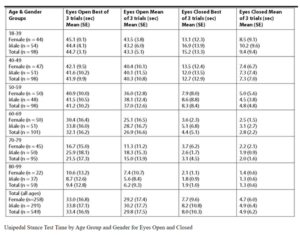Do As The Flamingos Do
Be ProActive and do as the Flamingos do!
Our ability to balance on one leg is challenged every single day with our daily activities. For every single step we take, we spend some time on one leg. Every stair we climb or descend, when mounting a sidewalk curb, turning around, or putting our pants, socks and shoes in the morning, etc…all these activities involve single leg balance. Yet, how much time do we spend training ourselves in this fundamental ability? This is especially important when the majority of people have a dominant leg that they favor, and consequently, a weaker leg as well.
In our clinical encounters, evaluating for symmetrical single leg balance can often help reveal root issues and even assess for risk of future injury.
So how good are you at balancing on one leg? Try it out on both legs, time yourself, and then compare it to the chart below of the average time healthy individuals can stand on one leg depending on age groups. (Springer B. et al., 2007).

There are many reasons we end up developing one stronger leg as we age. Some reasons are intangible and include our natural tendencies. Other reasons often involve injury and pain. We may have sprained an ankle and had to walk several weeks favoring one leg. We may have had to wear a cast on one leg, had surgery on one leg, or developed a bunion in one foot, etc. These unilateral injuries necessitate compensation patterns with the good leg needing to carry the load until recovery.
The danger is when the compensation patterns don’t disappear even after recovery. We continue to rely on one leg heavier than the other by habit, all the while continuing to lose confidence in the other. An example would be no longer alternating our legs on stairs, but rather, leading only with one. The compensation patterns are reinforced over time and the differing strength/coordination abilities between both legs become greater. Soon the two legs are no longer symmetrical in power, coordination and balance. Whatever the reason for asymmetry, having equal ability and confidence in each leg is critical.
So start training them! A great starting point is practicing standing on one leg while brushing your teeth. Two minutes on the right leg in the morning, and two minutes on the left leg just before bed.

The final question is, do flamingos ever switch legs?
